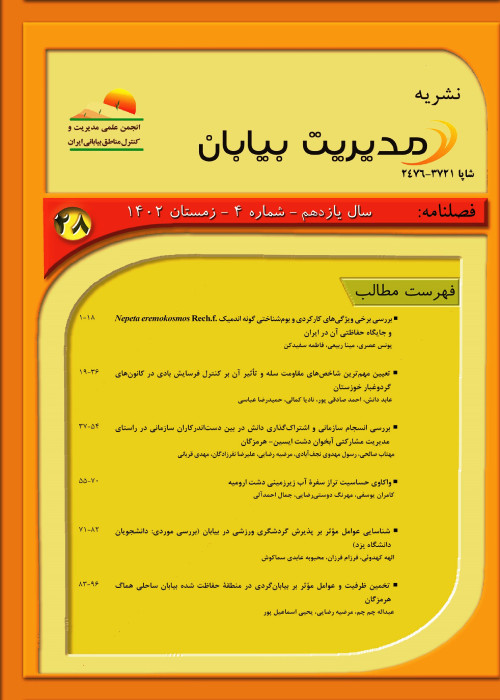Identifying and Determining the Length of The Greenhouses Cultivation Period Using Aerial Photos and Sentinel-2 Images
Author(s):
Article Type:
Research/Original Article (دارای رتبه معتبر)
Abstract:
IntroductionOver the past 60 years, the use of plastic covers as a tool to increase the harvest and increase the yield of horticultural crops has steadily increased worldwide. Plastic greenhouses have turned desert areas into areas with modern agricultural development, the province of Almera in the south of Spain is a good example. It now has many greenhouses, making it a global model of agricultural development; but greenhouses contain large quantities of phthalates and cause harm to people, like hormonal disturbances, heart problems, cancer, etc. However, plastic greenhouses are widely built to produce vegetables and fruits near cities. As a result, several remote sensing methods have been developed to identify and monitor the distribution of plastic covered greenhouses in order to manage water resources, identify sites and quantities of plastic greenhouses. Remote detection is the only practical method to monitor plastic greenhouses in a vast geographic area. In the past few years, there have been few studies using high spatial resolution images. In one study, three main absorption ranges were identified that are unaffected by dust, washing and surface factors. In Spain, an artificial intelligence neural network has been proposed to identify greenhouse using Quick Bird images with a resolution of 1.5m. Studies based on medium spatial resolution imagery were also conducted, resulting in different results. In search on land cover classification using Landsat TM images, no favorable results were found. Research has proposed a new method for mapping greenhouses using Sentinel-2 dual-time images and 1D-CNN deep learning. The aim of the current research is to identify the length of the cultivation period of greenhouse crops using Sentinel-2 satellite images. Researchers used a variety of satellite imagery to identify and classify greenhouses. The innovative objective of the current research is to evaluate the Sentinel-2 satellite images in determining the length of the cultivation period of greenhouse crops; which was done for the first time within the country. Material and MethodsIn the first step, the cultivated area of greenhouses was identified using an aerial photograph. Then, useful bands were extracted in greenhouse studies using Sentinel-2 time series images. Next, vegetation and plastic cover indices were calculated for the greenhouse growing period. 1) Identify and determine the area under cultivation in greenhouses: By comparing the pixel-based classification algorithms and the object-oriented classification algorithms, the cultivated area of greenhouses was identified. ENVI and eCognition software were used for pixel-based classification and object-oriented classification, respectively. It should be noted that only one aerial photograph with three bands, blue, green and red, has been used in object-oriented classification. In order to classify the base pixel, learning samples were selected using expert knowledge from the study area. In some instances, Google Earth was used as well. Learning samples were selected scattered across the image to improve accuracy. For validation of the maps obtained from these algorithms, ground control points were used. To reduce human error, these points were also entered into Google Earth. 2) Identifying functional bands in the greenhouse study: The spectral behavior curve of different earth surface covers in Blue, Green, Red, SWIR, NIR bands was drawn in an image of the Sentinel-2 satellite. These spectral signatures were compared on May 20, 2020 i.e., when outdoor vegetation and greenhouse cultivation were at their peak. 3) Determining the duration of the greenhouse growing season: Vegetation indices of the NDVI, SAVI, OSAVI, MSAVI, GNDVI, RVI, DVI, RGVI, IPVI and plastic cover indices PGI, RPGI, PI, PMLI were compared using Sentinel-2 satellite time series images. Results and DiscussionGreenhouse cultivation is used to improve quality and increase food production. However, their development has many negative effects on the environment. Therefore, obtaining accurate and timely information on the distribution of greenhouses and the time of planting and harvesting crops under plastic covers can make a significant contribution to agricultural management, water management and soil protection. The present study is the first study to identify the length of the greenhouse cultivation period using Sentinel-2 satellite time series images. The results showed that among the object-oriented classification algorithms, two classification algorithms, Bayes and KNN, were more precise for the identification and determination of the cultivated area of greenhouses. The reflection of the plant below the plastic cover of the greenhouse in the NIR, Narrow NIR, Red Edge and SWIR bands increases by an equal amount in comparison with the reflection from the vegetation in the open space. Comparing vegetation cover and greenhouse cover indices showed that the indices designed based on SWIR and Red bands showed greater reflection during the hot season of the year. Indices based on NIR, Narrow NIR, and Red Edge bands were more reflective from October to late February. Based on the results obtained from the ground truth data, greenhouses are plastered during the warm season. This caused an increase in the reflectance in indices designed based on SWIR and Red bands and a decrease in reflectance in indices designed based on NIR, Narrow NIR, Red Edge bands, during the hot season. Therefore, combining all indices, two crop periods were observed: the first started in early March, peak cover was reached in April, and harvest continued. Until the middle of August. The second harvest started at the end of August and peaked in December, until the end of harvest in mid-February.
Keywords:
Language:
Persian
Published:
Desert Management, Volume:11 Issue: 25, 2023
Pages:
19 to 38
magiran.com/p2597922
دانلود و مطالعه متن این مقاله با یکی از روشهای زیر امکان پذیر است:
اشتراک شخصی
با عضویت و پرداخت آنلاین حق اشتراک یکساله به مبلغ 1,390,000ريال میتوانید 70 عنوان مطلب دانلود کنید!
اشتراک سازمانی
به کتابخانه دانشگاه یا محل کار خود پیشنهاد کنید تا اشتراک سازمانی این پایگاه را برای دسترسی نامحدود همه کاربران به متن مطالب تهیه نمایند!
توجه!
- حق عضویت دریافتی صرف حمایت از نشریات عضو و نگهداری، تکمیل و توسعه مگیران میشود.
- پرداخت حق اشتراک و دانلود مقالات اجازه بازنشر آن در سایر رسانههای چاپی و دیجیتال را به کاربر نمیدهد.
In order to view content subscription is required
Personal subscription
Subscribe magiran.com for 70 € euros via PayPal and download 70 articles during a year.
Organization subscription
Please contact us to subscribe your university or library for unlimited access!



